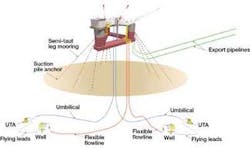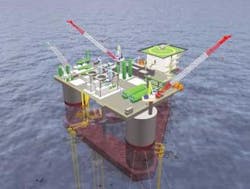Floating production facilities to produce marginal deepwater fields
Low-cost production solution ready for the GoM
Joe W. Key
Friede & Goldman Ltd.
As gas supplies decrease and demand continues to increase, the importance of producing marginal fields becomes more important. Friede & Goldman Ltd. has designed a series of very small production units for marginal deepwater fields in water depths from 1,000 to 6,000 ft.
null
The Centurion class floating production facility (FPF) has been designed as a stand-alone unit that can be used as a small production hub or can be moved from one location to another as fields are depleted. This makes it possible to write off the capital expenditure over the combined life of multiple fields, which greatly enhances field economics.
The Centurion FPF is ideally suited for gas fields or fields with relatively small quantities of oil. Designed to withstand 100-year storm criteria and loop currents as high as 4.1 knots, these units are ideally suited to work in the Gulf of Mexico. Minor changes can be effected if more severe environmental conditions are anticipated.
The Centurion design
The Centurion FPF units are simple semisubmersibles with a triangular-shaped ring pontoon, three main columns, three minor columns, and one or two decks. The three standard units are:
- Centurion MVP – 2,500-ton deck load
- Centurion MVP 3 – 3,000-ton deck load
- Centurion MVP 4 – 4,000-ton deck load.
The hulls of the three units will be constructed in the same manner and are very similar except for the dimensions and steel weights.
The Centurion MVP-3 is the most mature of the three designs. The production facilities will be adapted for each specific field to satisfy variable reservoir parameters. The Centurion MVP-3 FPF can handle up to 300 MMcf/d of gas, or 40,000 b/d of oil, or some combination of oil and gas.
The FPF will handle up to six production risers, six independent control bundles, and two export risers. Additional risers could be incorporated in the basic designs.
The operating draft and the survival draft have a range of 54-55 ft to minimize the need for ballasting functions to maintain the proper draft as the amount of consumables fluctuates day to day. The unit will accommodate 12 people.
More than 21 watertight compartments in the ring pontoon provide reserve stability if the unit sustains damage. The compartments also allow access for hull inspection and maintenance without requiring dry-docking.
Normally, the exterior compartments will be ballasted with water to achieve the desired operating draft. The interior compartments normally stand empty. Ballast water can be transferred to the interior compartments when access to the exterior compartments is desired.
The major columns include 27 additional watertight compartments that are voids that provide full access to all compartments in the ring pontoon. Box girders support the production modules and the utilities systems.
Flexibility
Design objectives targeted hull construction that would provide maximum flexibility for relocation without the need for dry-docking or hull modification.
Topside production facilities will have to be designed to match site-specific reservoir characteristics and production rates. F&G envisions three to six self-contained production modules that can be fabricated at multiple sites and then installed on the deck of the Centurion FPF. The shipyard that constructs the hull would lift the modules, connect them to the deck, and complete all pre-commissioning before moving the unit offshore. This construction program greatly reduces the time, capital costs, and risks during offshore installation and hook-up.
The initial production modules will be removable so they can be replaced with other pre-constructed modules to adapt prod-uction facilities to suit the spe- cific field development require- ments. Modification can be done alongside pier facilities. Mooring lines and flexible pipe risers could be used at subsequent locations by changing the lengths if there are major changes in the water depths.
Mooring system
There will be only minor variations in the deck loads when the unit is in operation. No mooring winches or windlasses are required to change the mooring tensions after the unit is installed on location. The FPF will have nine mooring lines in a semi-taut configuration for water depths of 2,000-6,000 ft. A catenary configuration will be used for water depths less than 1,500 ft. Synthetic mooring lines will be used for water depths greater than 6,000 ft.
Mooring swivel padeyes will be an integral part of the three major columns of the Centurion FPF. Suction piles or suction embedded plate anchors (SEPLAs) will be pre-installed at the prod-uction site. Subsea connectors and an underwater rat- chet system will connect the mooring lines between the mooring swivel pad-eyes and the suction piles or SEPLAs.
This approach streamlines the offshore installation and hook-up of the mooring lines, reduces offshore installation costs, and allows early installation of the suction piles or SEPLAs so soils can consolidate before the FPF arrives at the operating site. This facilitates replacement or relocation of the mooring lines. The approach also eliminates the need for onboard winches or windlasses and chain lockers. Greater space and deck loads can be devoted exclusively to topside production facilities and the utilities systems.
Production and export risers
The Centurion vessels are compatible with the flexible pipe or steel catenary risers for both the production and sales risers. The final selection depends on water depth, diameters, anticipated field life, initial capital expenditure, and the possibility of reusing the risers at subsequent locations. Control umbilicals will be pulled through I-tubes constructed in the FPF hull and terminated just below the main deck.
The pontoons include numerous ballast compartments that can be free-flooded or evacuated with a compressed air system. The ballast system includes three dedicated low-pressure, high-volume air compressors. Ring piping has been included so that any pontoon compartment can be de-ballasted with any compressor. Trim pumps have been included in each major column for minor adjustments in the FPF trim with variations in the quantity of diesel and methanol that is stored on the FPF.
There is not a typical machinery space because there is no propulsion, and there are no pump rooms. Most of the machinery and equipment are located above the deck. There are no DC motors, DC electrical power generators, or drilling equipment on the unit. The unit will stay at the operating site for many years without dry-docking.
Stability and weight control
The FPF is not sensitive to water depths or the number of wells. It is, however, sensitive to deck loads, but far less sensitive than TLPs and Spars. The Centurion FPF units exceed the requirements of the regulatory agencies with respect to intact and damaged stability.
null
The hull is a simple pontoon constructed with flat plates. The Centurion FPF vessels can be fabricated at a large number of worldwide shipyards, including several in the GoM.
Advantages of building in the GoM include:
- Schedule reduction of six to eight weeks because the hull does not have to be transported from remote shipyards
- Topside production fac- ilities and utilities systems are more readily available and competitive
- Reduced shipping costs for major equipment
- Lower cost for construction management personnel be-cause of local availability.
The FPF hull can be fully outfitted with the production facilities alongside any pier with 20-ft water depth and suitable lifting devices. The facilities will be pre-commissioned at the fabrication site. Final tow to the operating site, hook-up, and commissioning will only take a few weeks.
The FPF can be built onshore and launched before or after the topside production facilities are installed, depending on the shipyard's capabilities.
Offshore installation
The mooring anchors or suction piles will be pre-installed at the production site while the vessel is being constructed. The completed Centurion FPF will be towed to the offshore production site and moored on location. Then, the production risers, sales risers, and the control umbilicals will be installed and tested. Final commissioning will occur when hydrocarbons are available for production operations.
null
When the initial field is depleted, the unit can be relocated. Designed-in flexibility allows the unit's production facilities to be modified easily.
During the past three years, F&G has completed major development, model basin testing, basic engineering, and extensive analyses of the hull for the Centurion MVP-3 production unit.
Model basin testing showed good motion characteristics, with reasonable agreement with the computer-generated results. Vessel stability is not sensitive to changes in water depth or the number of wells. Primary structural analyses of the hull were undertaken, and dynamic mooring analyses were carried out for water depths of 1,500, 3,400, 4,500, and 6,000 ft.
Shipyard specifications for construction and outfitting of the Centurion FPF have been completed, and an invitation to tender is ready to issue to qualified shipyards.
Author
Joe W. Key, P.E. is senior vice president for floating production systems at Friede & Goldman Ltd. Key has more than 35 years of offshore engineering and project management experience with field development studies, FPSOs, FSOs, semisubmersible-based floating production systems, shipyard construction and repairs, offshore construction equipment, and offshore installations.




